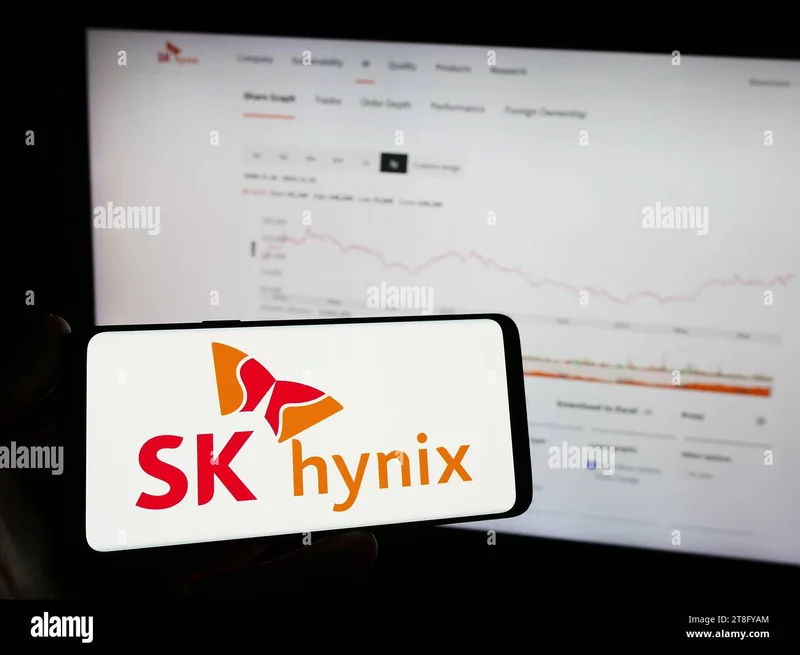Real-Time BNB Signal Analytics
Real-Time BNB Signal Analytics
SK hynix Announces Q3 2025 Financial Results landed before the Seoul market opened, a pre-dawn data bomb that sent futures soaring. The headline numbers were, to put it mildly, astronomical. A quarterly revenue of ₩24.45 trillion is impressive. An operating profit of ₩11.38 trillion is extraordinary. But it’s the operating margin that forces you to sit up and re-read the filing: 47%. In the notoriously cyclical, capital-intensive, and cutthroat memory chip business, a nearly 50% margin isn't just a good quarter; it's a statistical anomaly.
For years, memory has been treated as a commodity. Prices for DRAM and NAND flash rise and fall with the brutal logic of supply and demand, often leaving balance sheets in tatters during downcycles. But the Q3 numbers from SK Hynix don't describe a commodity business. They describe a company holding a strategic chokepoint in the single greatest technological build-out of our generation: the AI infrastructure boom. The market’s reaction, sending the stock soaring past ₩540,000, wasn’t irrational exuberance. It was a delayed, and perhaps still incomplete, recognition of a fundamental paradigm shift.
The driver, of course, is High Bandwidth Memory (HBM), the specialized memory stacked right next to Nvidia’s GPUs that acts as the chip’s short-term memory. It's the critical component that feeds the AI beast. SK Hynix’s report makes it clear this isn’t just a rising tide lifting all boats. Sales of high-capacity DDR5 server modules more than doubled from the previous quarter. The portion of high-priced enterprise SSDs expanded significantly. This is a company firing on all cylinders, but the engine is HBM. This isn't like selling shovels during a gold rush anymore. That analogy is obsolete. This is like being the sole patent holder for a self-guiding drill that not only finds the gold but refines it on-site. The pricing power is absolute.
And this is the part of the report that I find genuinely puzzling. SK Hynix claims it has already completed discussions with key customers for HBM supply for all of next year. It states that demand for its entire DRAM and NAND production for 2026 is already secured. This claim is significant, with reports noting that SK Hynix, a critical Nvidia supplier, is already sold out for 2026 as AI demand booms. What does "secured" actually mean in this context? Are these legally binding, non-cancellable purchase orders, or are they strong indications of interest? The distinction is critical. If it’s the former, then SK Hynix has achieved a level of forward-looking revenue visibility that is simply unheard of in the semiconductor industry. It would imply that customers like Nvidia are so desperate to secure supply that they are willing to lock in orders years in advance, effectively underwriting SK Hynix's future. If this is true, is the company even a cyclical stock anymore?

While the income statement gets the headlines, the real story of a company’s health is often told on the balance sheet. And here, the transformation is even more stark. SK Hynix ended the quarter with ₩27.9 trillion in cash and equivalents against ₩24.1 trillion in interest-bearing debt. That puts them in a net cash position of ₩3.8 trillion. I’ve looked at hundreds of these filings, and a shift from significant net debt to a positive net cash position this quickly is exceptionally rare. It tells you the cash flow isn't just strong; it's torrential.
This financial fortification changes everything. It means the company can fund its aggressive capacity expansion—like the early opening of its M15X facility—without taking on punishing debt. It can accelerate its migration to the next-generation 1cnm process node without blinking. This isn't just about profiting from the current boom; it's about building a financial fortress to dominate the next one. The company is using this unprecedented gusher of AI-driven cash to permanently alter its competitive position.
We’re also seeing validation from the so-called "smart money." The number of funds and institutions reporting positions in the company rose by nearly 6% in the last quarter to 524. The average portfolio weight dedicated to the stock jumped by about 30%—to be more exact, 30.32%. This isn't retail FOMO. This is a calculated, institutional shift, a recognition that the company's risk profile and growth trajectory have fundamentally changed.
Yet, a curious discrepancy remains. The average one-year analyst price target sits around ₩482,850. After the post-earnings surge, the stock is trading well above that consensus. This presents two possibilities. Either the market is overextended and due for a correction, or the sell-side analysts who build these models simply can't update them fast enough to account for the sheer velocity of this market shift. Their models are likely still pricing in a degree of cyclicality that may no longer apply. How do you model a company that is essentially sold out for the next two years in a market with seemingly insatiable demand?
The numbers presented by SK Hynix are more than just a record-breaking quarter. They are a data point suggesting the entire structure of the memory market is being reshaped by the gravitational pull of AI. The company is no longer just a component supplier; it's a gatekeeper to a technological revolution. The forward-looking statements, if taken at face value, indicate a degree of pricing power and demand visibility that transforms the business from a volatile commodity producer into something far more stable and far more profitable. The market seems to believe it. The institutional money is flowing in. The only question is whether this AI-driven demand curve is a permanent new plateau or a temporary spike. For now, every single data point suggests the former.